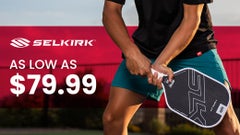Best Tips and Drills for Mastering any Volley in Pickleball
Whether you are a new or experienced pickleball player, the volley is one of the most important shots because it's versatile enough to keep you in points and key to ending them on your terms. Follow along to as we help teach how to hit effective volleys and how to practice them into perfection.
Pickleball Volley Tutorial
First things first, at its most basic a shot or ball struck in the air before it bounces is a volley. We’re going to cover three types of pickleball volleys: block volley, roll volley and the speedup. The block volley is the simplest volley. The other two are a little more advanced but are built on the same fundamental techniques, so let’s started.
Volley Ready Position
- Begin with the standard athletic position. Both feet are spread a bit wider than your shoulders, along with a slight bend of the knees and hips. This provides a strong base of stability to absorb whatever shot comes your way and the ability to quickly respond to pace and directional changes of play.
- Keep your weight leaning slightly forward with a little more of it on the balls of your feet so you can shuffle forward, left, right or backward as needed.
- Position the paddle in front of the body and eyes, around waist height with the tip of the paddle pointed upward above the hand. Maintain an open stance while hitting a volley whenever possible.
Quick Tip: In general, it is better to hold the paddle with a relaxed grip. Grasping the handle at about 3 or 4 out of 10 in terms of tightness is suggested before and in between volleys. To compensate for the impact of the volley, a slight increase in grip pressure at the moment of ball contact will steady the result.
The Block Volley
- Keep the paddle out in front of the body and use a very short backswing.
- For a block volley you are basically slowing down or even stopping the paddle face on the bottom portion of the ball. Focus on keeping the paddle steady, relying more on the ball bouncing off the paddle face rather than swinging at it.
- If the incoming shot is hit hard or you are volleying on the stretch, you may want to brace for the impact of the ball with a light squeeze of the handle along with a slight upward punch through the bottom of the ball.
- Some instructors emphasize keeping the paddle face open (pointed slightly toward the sky), and others prefer to have players focus on making contact on the bottom portion the ball. Either way, the desired result is that your volleys arc over the net.
That’s all it takes to hit your basic volley!
Quick Tip: If the ball drops down (at all) as it exits the paddle face for a volley, it is likely going to hit the net. Even if contact is at shoulder height, you are seven feet from the net at the NVZ line, so the ball needs some lift off the paddle to make over and past the net.
The Roll Volley
- Maintain an open stance and use the arm to create a small backswing of the paddle.
- Like the basic volley, make paddle contact of the paddle face on the bottom portion of the ball.
- Your follow through will be a bit longer than a traditional volley. Smoothly extend the arm and hand up toward the target without much wrist movement or change to the angle of the paddle face throughout the swing. This motion creates some topspin, causing the ball to dip down instead of flying long and also makes the reply difficult to attack.
Quick Tip: This variety of volley is very useful when replying to softer dinks and volleys at the NVZ line. If you are close to the kitchen and shot contact is below the height of the net, hitting the ball aggressively is high risk and will cause the shot to land in the net or fly long. Softly rolling volleys from a low contact point will maintain shot neutrality.
The Speedup Volley
- Start in the standard athletic position with the paddle out in front of the body. There is almost no back swing involved for this shot, and after initial contact, your paddle face goes from being somewhat open to vertical and finishes closed as you drive forward over the top of the ball. The result is more pace and shape on the ball.
- The speedup volley requires the most paddle swing speed.
- Picking the right height of shot is key for producing effective speedup volleys. If shot contact is at waist level or above the net cord, that is a green light for a good speedup volley.
- It's a red light if shot contact is below the net cord. Instead, stick with the basic or roll style of volley.
Quick Tip: Aiming speedups or put-away volleys toward the hip and/or shoulder of the dominant side of the opponent's body is effective because it is difficult to produce a good reply from those areas of the body.
Pickleball Volley Drills
- Basic Volley Drill: With two or four players near the kitchen line, keep the volley exchange at a slow to medium pace. The idea is to maintain control for as many consecutive volleys as you can. Aim to hit 20 volleys in a row.
- Rolling or Speedup Volley Drill: This drill can be played with two to four players and challenges players to hit every volley some degree of spin. To start, feed the ball in at a slow pace then look to speed up the pace of the volley when the opportunity presents itself. For this drill, the pace is faster than what is used for the basic volley, but whether you are rolling volleys at medium or high speed, the focus should be on the quality of the shot and reaching at least 20 to 30 consecutive volleys.
- Backboard Drill: When you’re working on your game solo, a wall or the mobile Dink Master training board is impossible to beat for volley practice. Unlike most backboards, which tend to be vertical,the Dink Master can be tilted back. The slight upward angle forces the ball to exit the board with a slight arc, instead of dropping down, so you can step back and generate long rallies that mimic actual play.
In Conclusion
The volley is a vital shot in pickleball. It can be used defensively or offensively or, in other words, to extend or end a point. The most basic volley, or block volley, focuses on getting the paddle face into position without much backswing and little to no follow through after contact. The other two volleys are more advanced and used more offensively. Rolling volleys adds some topspin to the ball, and finally the speedup is primarily a faster hit version of the rolling volley.
Each of these volleys builds on each other and becomes a little more complex, meaning more body and paddle movement is needed. The good news is that you do not have to wait until you are an advanced player to learn how and when to use them. All are relevant at any level and whether you play for fun or like to compete. Best of all, once you understand and practice the mechanics of the volley you can continually improve that part of your game.










